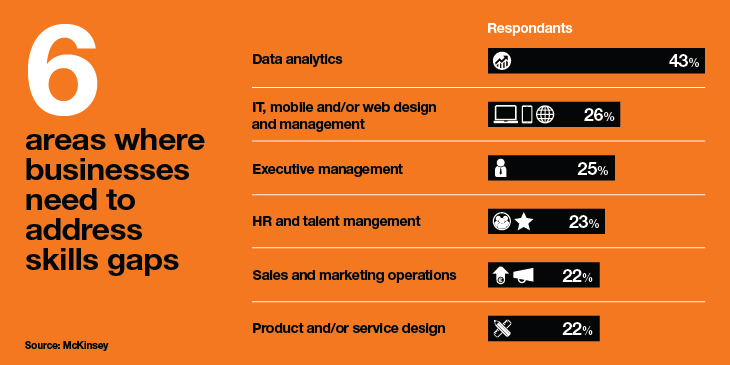Of greater long-term concern, however, could be the way behaviors change and the lasting impacts that could have. With the signs pointing to the emergence of a touchless economy and companies turning to automation to meet the demands of rebuilding production while incorporating social distancing and other health and safety measures, many roles could become obsolete.
Yet at the same time, research from Google and McKinsey suggests that even accounting for expected job losses, Europe may have a shortage of workers rather than a shortage of jobs in 2030.Or, as Matt Britten, Google’s President for Europe, the Middle East and Africa (EMEA), put it, “automation in Europe is not the threat to jobs that some people fear.”
That said, the study found that these opportunities will not be spread evenly across the region, and that part of the reason for the gap will be the requirement for new skills. Ninety million workers may need to develop significant new skills within their current roles, while up to 21 million may have to leave declining occupations. But what are these new skills?

The challenge of predicting new skill requirements
The pace of change in technology and the rapid implementation of the likes of artificial intelligence, machine learning and robotic processing automation, mean that the skills required in 2030 could well bear only a passing resemblance to what people think might be needed.
It will also vary from employer to employer, as companies’ digital transformation agendas and progress dictate the skills they need. This is borne out in the way that businesses as varied as Amazon, JP Morgan Chase and Walmart are already developing programs to retrain and upskill employees.
What does it mean to be human?
Amazon, for instance, is focusing on developing technology-focused talent, such as training warehouse employees to became basic data analysts. Walmart, however, is looking at ways to develop soft skills in its employees as part of its Walmart Pathways program, a $2 billion investment in training.
These examples highlight how the types of skills in demand can fall into specific categories. A separate McKinsey study identified these as higher cognitive, technological, social and emotional skills. It found that of the top five in demand, two were classed as social and emotional, two higher cognitive, and one technological. This tallies with a European Commission report, which stated that “a moderate level of digital skills and strong non-cognitive skills are expected to be required for most jobs in the future.” In other words, the majority of roles will require some technical knowledge but a significant amount of social and emotional ability.
Combining the data from these studies and the steps a variety of businesses are taking indicates that it is what makes people human, the social and emotional skills, that will be most in-demand in future roles.
Technology as job creator
It is, therefore, possible to see a point where technology is deployed to augment human workers. Technology, or machines, would be used to do the tasks to generate a finished product, which could be anything from manufacturing a car, to producing data reports, or developing physical prototypes for architectural or design concepts. Employees would be involved in the points at which an emotional connection is required – engaging with customers, providing initial ideas or designs, making decisions and communicating effectively and empathetically.
Travis Hessman, Editor-in-Chief at Industry Week, illustrated this opportunity in an article in July 2019, saying, “The human asset goes far beyond labor. Every worker on the floor is filled with ideas, insights, perspectives and abstract creative genius that no machine and no software can duplicate. The challenge now is to redefine our strategies to tap into that, to harness the true human potential.”
There are many examples where the introduction of automation has led to an increase in workforces. According to a Forbes article, two U.S. manufacturers saw productivity increase following the introduction of robotics, with employees upskilling and both companies expanding their workforces to cope with the output from the robots.
The augmented worker
To avoid a combination of mass unemployment and significant skill shortages requires governments and employers to redefine their strategies, as Hessman says. A wholly human workforce will be unable to compete against a more digital organization. Yet to be truly successful, the latter will need to have human employees in the right roles. The jobs market in 2030 is impossible to predict, but the available evidence suggests that many roles will require a technical understanding underpinning fully developed social and emotional skills. In short, a combination of technology with what makes people truly human.
Read how Orange helped support contact centers during the COVID-19 lockdown with the rapid introduction of AI-powered chatbots; watch the Orange Silicon Valley webinar on the future of education; and discover our range of data and AI services.